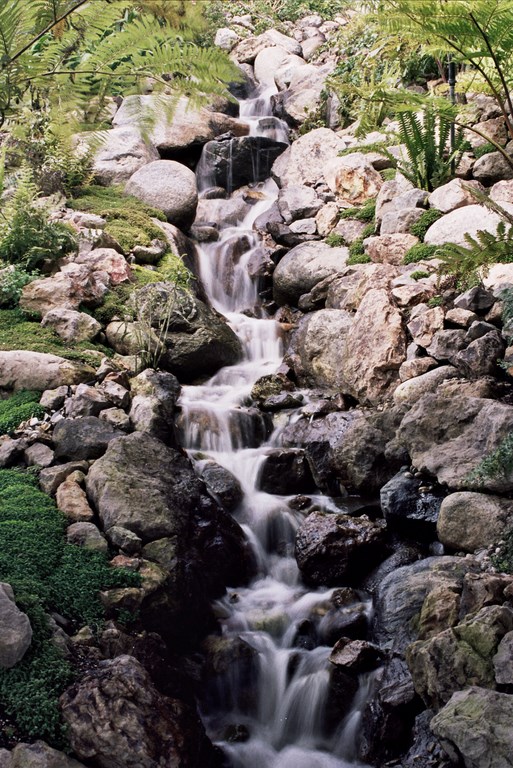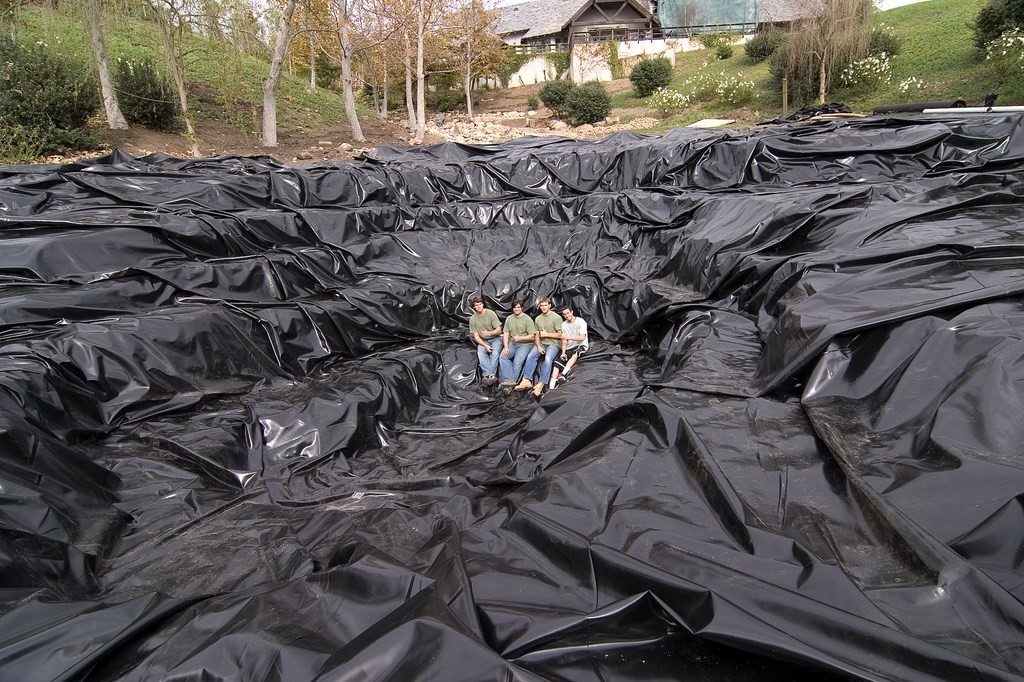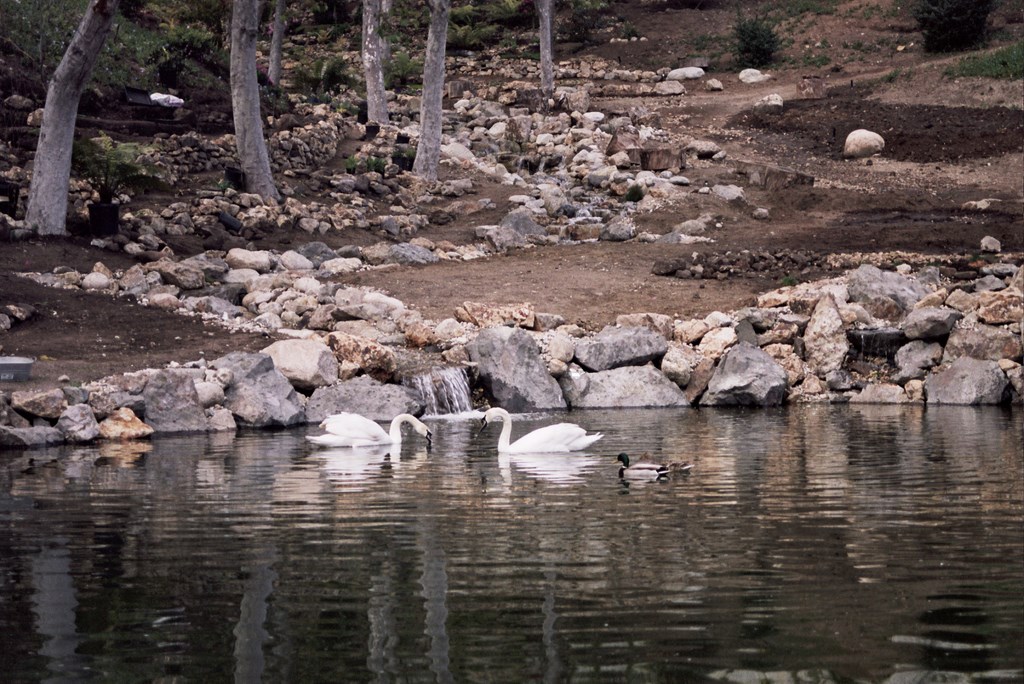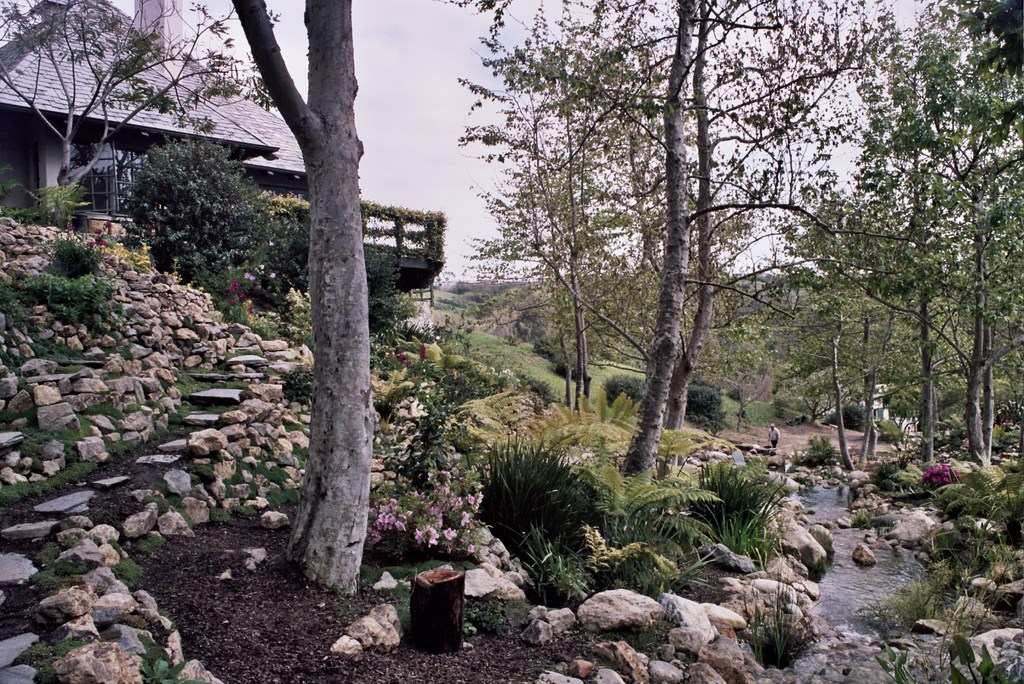Graceful Cascades

It certainly doesn’t happen very often, but sometimes the addition of a watershape can completely redefine the way a property is perceived.
In the case seen here, a nine-acre estate in the mountains above of Malibu, Calif., was zoned for agriculture. The owner’s intention in buying it was quite appropriate: He wanted to turn it into a working vineyard brought to life visually by a big stream, pond and waterfall system.
Once the watershape took form, however, the owner was so inspired by what he saw that his vision for the property changed and he recast the place as a venue for weddings and other events that would be enhanced by the bucolic, utterly romantic surroundings. In a very direct way, in other words, the watershapes served to increase both the aesthetic and financial value of the property.
I’m a romantic at heart, so the notion that the work on display here will be a backdrop for special, memorable occasions has made the big, complicated project even more gratifying than it would have been otherwise.
WEIGHING CHOICES
As is true of most of the projects we tackle at Mystic Water Gardens of Encino, Calif., this one came to us through a referral and a bit of small talk. As we were wrapping up a pond project for a client in Ojai, Calif., he mentioned that he had a friend in Malibu who had just received a bid to install a waterfall, stream and pond from a pool contractor that seemed quite high relative to his own experience with us.
As it turned out, the bid was based on an all-gunite system, which can work well if the builder really knows what he or she is doing and can overcome the tendency these structures have to look rather unnatural. It also emerged that the builder who had submitted the original bid had no experience with stream or pond work, and what the plans revealed was basically a pool that sort of looked like a stream and a pond.
| We were aided in the design and installation processes by the natural contours of the property, which started on a slope behind the home and flowed down to a lawn space easily excavated to become the bowl of a large pond. |
I called the Malibu client at my Ojai client’s suggestion and said I would be more than happy to give him advice and advance the design. As the conversation progressed, however, it was clear he was hanging on everything I said about creating natural-looking systems and asked me to visit the site and get the lay of the land.
What he was after was definitely a complex, expansive set of features – and on a scale that went way beyond the majority of residential projects.
After our initial meeting, we hit the road to visit concrete pond/stream structures as well as those installed using liners. The more natural appearance of liner systems appealed to him, but even more, he was pleased by the prospect of lower maintenance and the chemical-free nature of our approach to water treatment. Before we were through, he had moved entirely in our direction.
| Of all the photographs we took as our work progressed, perhaps no single image indicates the grand scale of the project better than this one, taken just after we finished laying out the pond’s 80-by-100-foot liner. |
The design now includes a 35-foot-tall waterfall that descends to (and beneath) a large wooden bridge, transitions to a 300-foot stream and terminates in a large pond that measures approximately 80 by 100 feet. More than 1,000 tons of rock material ranging in size from multi-ton boulders to cobble and pea gravel were used.
The circulation all appears continuous, but there are actually two systems – one for the waterfall, the other for the stream and the pond. This dual system was needed to avoid having to pump water the entire distance (and rise) from the pond to the top of the waterfall.
In addition, the system has been set up to handle storm runoff through a system of hidden drains and culverts. Filtration is handled within the watershapes in the form of under-drains, one located in a “dry pond” at the low point of the upper system and another in the large pond below. Suffice it to say that the design phase for the project involved a huge amount of planning, engineering and general preparation.
FISH SCALE
The pond at the bottom of the system sits in a large, flat area – quite serene and park-like. Freeform in shape, the watershape is surrounded by mature oak trees and landscaping with rockwork seamlessly woven into the shoreline to create soft transitions from the water’s surface into the encompassing grounds. (For more on these edges, see the sidebar just below.)
In the original plan, the pond was to be five feet deep. In the middle of construction, however, the client decided that he wanted to stock it with trout, which require deeper water so they can escape the heat and sunlight. The change came well before we’d installed the liner, so the only consequence was that we had to come back in and re-excavate the basin.
|
On the Edges To me, edge treatments separate the experts from the beginners in pond and stream work. To that end, my crew and I go to tremendous lengths to establish rock and plant configurations along the edges that feather the stream and pond edges into the landscape on one side and into the water itself on the other. We start by excavating the site so that there are varied contours along the edges – all sorts of shelves, outcroppings, coves and estuaries. When we install the liner, we fold it under along the edges of the stream course, backfilling the outside with soil that enables us to bring plantings and partially buried rocks right to the water’s edge. We also place boulders inside the stream that vary in the extent to which rise above the water’s surface or remain submerged. We play with the sizes of the rocks in all sorts of patterns and orientations, always with the aim of obscuring the edges so the viewer has no sense of where the landscape begins and the watercourse ends. — S.S. |
In developing any system intended to harbor animal life, you either must select the species based on the physical configuration of the system or, as proved to be the case here, modify the design to accommodate the species. Either way, you have to be aware of the needs of the animals to create harmony and congruence between the watershape and its intended occupants.
By way of contrast to this quiet, reflective pond, the waterfall at the other end of the project was intended to create a visceral sense of excitement. It begins on a level above the house, descending down a steep slope and flowing beneath a pedestrian bridge that leads to the home’s entrance. On one side of the bridge, the viewer is just a few feet away from a thrilling whitewater cascade.
We achieved this effect by sending a relatively large volume of water through a fairly narrow channel courtesy of our rock configurations. There aren’t any knife-edge weirs in the mix: They don’t tend to look natural in such settings and aren’t too effective in shaping the hyperactive, crashing cascades we were after.
Again, understanding the purpose of the water in a given area influences everything that goes into a project, from the first shovel of dirt that’s excavated. In the case of this waterfall, we worked as much as possible with the natural contours of the slope, which was helpfully steep in most places. Even so, we over-excavated the channel with all sorts of shelves and indentations to give us places to located key boulders, govern vertical transitions and give us the broken, irregular water flows the client wanted.
EARTHEN FLOW
While the steep slope was a structural advantage, it also meant that, for the most part, the waterfall and much of the lower streambed had to be excavated by hand.
With this sort of waterfall and stream work, there’s a give and take between the existing landforms and our need to mold and control the watercourse. We know that the process of placing rocks after the liner has been installed is largely intuitive and that the “design” emerges on site and in the moment: It is therefore critical to set up these contours in a way that gives us flexibility and sets the stage for the improvisational work of installing the boulders that really define the system.
| We took full advantage of the property’s natural slope with the waterfall system. Our work here was guided by our study of natural streams in the area and led, for example, to our insertion of the dead-fall tree and our use of rocks of varying degrees of size and smoothness. |
In this case, the headwaters consist of two pre-fabricated waterfall units buried and concealed by rockwork and plant material at the top of the structure. I generally prefer to set up bogs that well up and spill into a watercourse, but that wasn’t an option here because of the steepness of the slope. We were, however, able to establish this sort of bog on the flatter ground at the head of the project’s lower system.
As mentioned above, the overall composition is split between the waterfall and the stream/pond components. The transition between the two is handled by what we call a “dry pond” area – basically a place where we dig a large depression in the ground, install an under-drain suction manifold and fill the entire structure with large rocks. The water flowing from the waterfall flows through the rocks before moving back to the top of the falls.
| The bridge is the literal turning point of the watercourse. The upslope view of the waterfall from the bridge is among my favorites anywhere on the property (left), but turning around and looking downslope is also rewarding (middle). And of course, bridges have a special drama and romance all their own when taken in from a good downstream perspective (right). |
In this same area, we established two bogs in which the water for the stream/pond system wells up and begins to flow. We intertwined and integrated the rockwork for all three elements, so the appearance is of a set of irregular pools. As a result, it is virtually impossible to tell where one system ends and the other begins. (Since we finished our work, we’ve asked a number of people to see if they can spot the transition point, and none have yet been able to do so without our pointing it out.)
Yes, we’re proud of this clever circulation configuration, but the reason it works is because it’s all based on what happens in nature as water flows over topographies of this sort. We couldn’t have fooled the eye nearly as effectively had we not been keeping natural models in mind.
INTERNAL WORKINGS
The dry pond is one of two locations that serve the composition as a combined suction point/biological-filtering area. The other is located in an area of the pond that’s on the far side of its intersection with the stream.
I’m a big fan of linking suction points with biological filtration: When you combine the action of the water being pulled through a gravel bed with the action of plants’ root systems removing nutrients from the water, you come very close to a system that is completely self-sustaining, “natural” and chemical-free.
| The pools that form the dividing line between the separate upper/waterfall system and the lower/stream/pond system are calm and their surroundings tastefully planted – the ideal space for whiling away some time in a comfortable chair. |
Five pumps of various sizes and flow rates drive the water flow from three separate locations. The pipes range from two to six inches in diameter, depending on the required flow, and we maximize hydraulic and electrical efficiency by using simple, straight-as-possible plumbing runs.
Then there’s the liner – the key to the success of any stream/pond project. In this case, we chose two different liner types.
In the pond is a single huge piece of 40-mil liner that was chosen because we could get it in one piece. Whenever possible, and especially in deeper water, I opt for a single-piece approach to avoid seams. (No matter how well you install them, seamed liners are always at risk for leaks.) The downside in this case is that the liner was huge: It weighed in at around 4,000 pounds, and it took 20 strong backs and sets of arms to unfold and spread it into place. For their parts, the stream and waterfall use 45-mil liners, which, oddly enough, were actually far more flexible than the thinner but more rigid material we used in the pond.
| The stream continues on a gentle path down the slope, finally turning for a final, sweeping run toward the pond below. This is a space designed for shade and intended above all for restful meditation amid the sheltering greenery. |
In all cases, we started with a non-woven geotextile underlayment to protect the liners from below. Once the liners were set, we’d go back and install an extra layer of underlayment in locations on which large boulders were to be placed. This sandwich approach serves to protect the liner from both sides.
For additional protection, all liner surfaces were covered with cobble and pebble material. This material also adds to the filtering action, serving as a habitat for small animals, beneficial algae and microorganisms that are essential to a healthy living system – and, of course, gives a boost to the project’s naturalistic appearance.
ROCKS AND SOFT SPACES
The importance of rock selection and placement in a project such as this one cannot be overstated. In fact, we see this as the phase of the project that truly makes or breaks its natural appearance.
All the rock for this project came from a local quarry and lends to the overall sense of integration by being indigenous to the area. As mentioned above, more than a thousand tons of material was delivered to the site, laid out in a flat staging area near the work and carefully sorted and selected.
| The pond is large and deep – the perfect home for the trout the owner wanted to raise. Complete with its own small fishing pier, it’s now a place for a different sort of relaxation and meditation. |
One area, for example, included boulders we’d chosen for key focal points based on their unique visual characteristics; another featured specimens chosen for their shapes and their potential for use in waterfall and cascade transitions; and yet another had boulders designated for structural uses of a less-visible sort.
The grading of the terrain goes a long way toward setting the stage for rock placement. We created all sorts of shelves, indentations and edge contours to guide those placements, but it’s important to note that no matter how much planning, strategizing and selecting we might do, the aesthetic details are all determined on site as we piece together the stones as a gigantic jigsaw puzzle.
This is where our long observation of natural systems is crucial. All of the stone setters we use study natural streams and ponds and do all they can to recreate those patterns. It’s an extremely difficult thing to describe or to teach, but my crews are at a point where they do it instinctively.
| Now that the project is finished, a home that had all sorts of untapped visual potential is now the crowning element of a composition into which it is fully integrated – a component in a painting in which land and water now flow easily around it. It’s an amazing transformation – one of which we’re all very proud. |
You simply have to use your eyes, appreciate natural waterways and figure out ways to apply what you’ve observed. As you work, it’s a constant process of improvisation as you place the stone material and visualize where and how the water will flow. For every single area we cover in stone, we will step back, assess, reassess and make minor or even major adjustments.
With that work done, our attention turned to the aquatic plants. I am strongly opposed to leaving plants in their containers: It’s such a glaring visual offense and the solution is so direct that I can only attribute leaving plants in the containers to either laziness or ignorance. Instead, we create scores of planting pockets from small to large, setting plants in soil and covering their bases with gravel and cobble.
Not only does this approach look great, but it also enables the root systems of the plants to interact with the water – another pathway to great water quality.
Plant selection and placement are important as well. In fast-moving water, for example, we use grasses, cattails and other species that are hardy enough to withstand the flow. In still areas, we went with lilies, hyacinths and other floating plants that do much better when their root systems are relatively undisturbed.
BRIDGE VIEWS
The proof of these measures – the degree to which we’ve create a successful simulation of nature – comes in both objective and subjective ways.
|
Caring to Share One of my philosophies is that there is everything to gain and nothing to lose from sharing and interacting with other people in my business, even with those who might consider themselves my competitors. With the job described in the accompanying text, for example, we conducted an open, informal seminar for some 20 of our colleagues during the installation of the liner in the large pond, discussing site preparation, the moving and unfolding and placement of the liner, edge treatments, rock placement, plant selection and just about every other detail of stream- and pondcraft. After conducting similar sessions several times in recent years, I can say without reservation that this approach has only led to more business, greater relationships and positive networking. At no time have I once felt that sharing with other professionals has in anyway shape or form compromised what I do: If anything, it’s led to more work and provided open dialogues through which everyone benefits. — S.S. |
On the functional side, once the system is filled and operating, we’re able to see how our planning for water flows and rock placement plays out and are able to make a variety of adjustments, some small, others significant. Also, we’re able after a few weeks of operation to see how well the water maintains itself. In this case, we’ve seen excellent water quality and a system that works as planned.
On the aesthetic side, you really have nothing to go on but your imagination until the whole system is up and running. In this case, the owner was so inspired that it changed his entire idea of how he’d be using the property.
From my perspective, I evaluate success based upon the way the views work and how well we’ve managed to integrate our efforts with the surrounding landscape and topography. Utility is also a factor, so I look at the pathways we’ve established and the stones we’ve set up as seating areas to create destinations and take advantage of special views as well as opportunities to interact with the water.
For this project, my favorite views are from the bridge. On one side, you see the cascades at close proximity; on the other, you look down over the long stream as it flows toward the pond several hundred feet away – and then up and out over the beautiful rolling mountains in the distance.
The true bottom line for projects of this scale and scope is how they make you feel while you’re there. In this case, aided by a gorgeous site, a healthy budget and a client with an uncompromising attitude when it came to achieving natural appearances, we were able to create a watershape that truly graces its surroundings.
Steve Sandalis is founder and president of Mystic Water Gardens, an Encino, Calif.-based designer and installer of custom streams, waterfalls and ponds. Sandalis founded the firm in 2000 after several years of pursuing watergardening as a serious hobby. Since then, he has immersed himself in arts and crafts of watershaping and currently designs and installs highly detailed watershapes for a range of mostly residential customers across the United States. A former model and actor, Sandalis appeared on more than 700 covers of romance novels published by Topaz, a division of Penguin Books, and has appeared in a variety of movies, television programs and commercials. A native of Commack, N.Y., he began working in the construction trades as a child with his father and uncles – all of them contractors in the area.

























